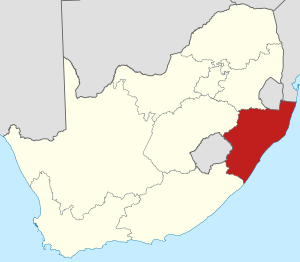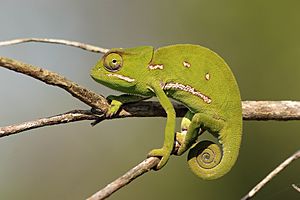KwaZulu-Natal facts for kids
Quick facts for kids
KwaZulu-Natal
|
|
|---|---|
| The Province of KwaZulu-Natal | |

Location of KwaZulu-Natal in South Africa
|
|
| Country | |
KwaZulu-Natal is a beautiful province in South Africa. It's often called the "garden province" because of its amazing natural beauty. Before 1994, this area was made up of two parts: the old Natal and the Zulu homeland called KwaZulu.
In the 1830s, the northern part of KwaZulu-Natal was home to the powerful Zulu Kingdom. The southern part was a Boer republic called Natalia. In 1843, Natalia became a British colony. The Zulu Kingdom stayed independent until 1879.
Today, KwaZulu-Natal is where the Zulu nation lives. It has two special natural areas, the iSimangaliso Wetland Park and the uKhahlamba Drakensberg Park. Both are so important that UNESCO has named them World Heritage Sites.
KwaZulu-Natal is located in the southeast of South Africa. It shares borders with three other provinces, the Indian Ocean, and the countries of Mozambique, Eswatini (formerly Swaziland), and Lesotho. Its capital city is Pietermaritzburg, and its biggest city is Durban.
Exploring KwaZulu-Natal's Geography
KwaZulu-Natal is about 92,100 square kilometers (35,600 square miles) in size. This makes it roughly the same size as the country of Portugal. The province has three main types of land.
The first is the lowland region. This area runs along the Indian Ocean coast. It's quite narrow in the south but gets wider as you go north.
The central part is known as the Natal Midlands. This area has many rolling hills and plateaus that get higher as you move west.
The third region is very mountainous. Here you'll find two big mountain ranges. The Drakensberg Mountains are in the west, and the Lebombo Mountains are in the north. The Drakensberg mountains have tall basalt cliffs that reach about 3,000 meters (9,800 feet) high near Lesotho. The Lebombo Mountains are older granite mountains that stretch south from Eswatini. The Tugela River flows from west to east across the middle of the province. It is the largest river in the region.
Along the coastal areas, you can find thick forests of subtropical trees and shrubs. There are also deep ravines where special Afromontane Forests grow. The midlands have moist grasslands and smaller patches of Afromontane Forest. The northern part of the province is mostly wet savanna. Up in the Drakensberg region, you'll find alpine grassland.
Health and Community
One of the challenges in KwaZulu-Natal, like in other parts of South Africa, is dealing with HIV infection. Health organizations like UNAIDS work to help people affected by HIV. They also try to prevent new infections. It's important for everyone to have access to health care, medicine, and good food to stay healthy. When many people are affected by health issues, it can slow down economic growth. This is because it affects the ability of people to work and contribute to society.
Images for kids
See also
 In Spanish: Provincia de KwaZulu-Natal para niños
In Spanish: Provincia de KwaZulu-Natal para niños











